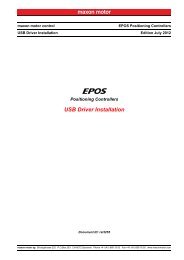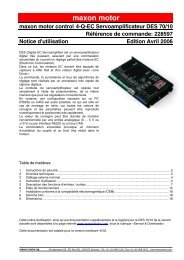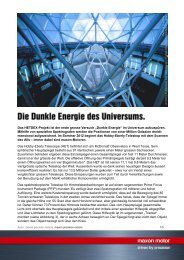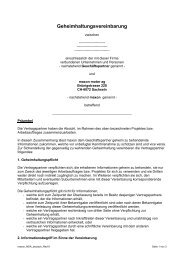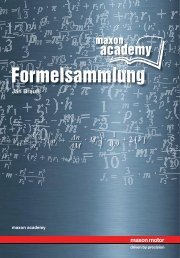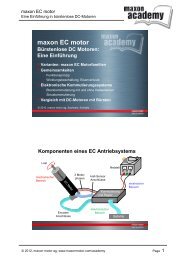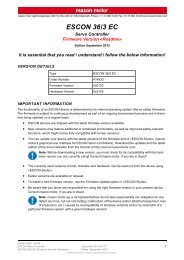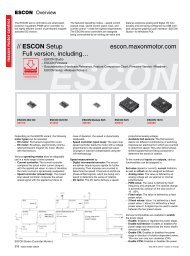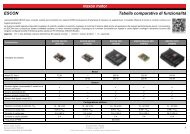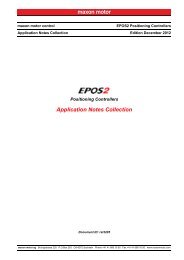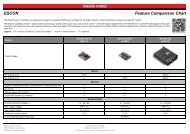EPOS2 Application Notes Collection - Maxon Motor
EPOS2 Application Notes Collection - Maxon Motor
EPOS2 Application Notes Collection - Maxon Motor
Create successful ePaper yourself
Turn your PDF publications into a flip-book with our unique Google optimized e-Paper software.
Controller Architecture<br />
Dual Loop Regulation<br />
In position mode, the auxiliary controller is designed to stabilize the loop, whereas the main controller<br />
provides the correct position feedback.<br />
The dual loop position controller (that is main controller and auxiliary controller together) is realized as<br />
PID controller and features the same sampling period as the dual loop velocity controller.<br />
Conversion parameters<br />
Conversion of PI controller and feedforward parameters in dual loop (<strong>EPOS2</strong> to SI units) are identical to<br />
that in single loop (chapter “9.3.3 Position Regulation (with Feedforward)” on page 9-121).<br />
9.5.4 Conclusion<br />
The dual loop topology is adequate if the ratio of motor inertia and load inertia is not too large. The drive<br />
elements (motor, gear, encoders, load) must be dimensioned correctly.<br />
General Selection Practice<br />
To achieve reliability of the system, follow the scheme below to determine the individual components:<br />
• <strong>Motor</strong><br />
Chose a motor capable to fulfill the load’s requirements for maximum torque, continuous torque,<br />
and speed. For detailed information chapter “1.6 Sources for additional Information” on<br />
page 1-11, item [ 7 ]).<br />
• Gear<br />
Chose a gear capable to fulfill the load’s torque and speed range. Boundary conditions are maximum<br />
motor load, maximum gear load, and the associated speed limits.<br />
Another influence that might need consideration is the minimum motor heat dissipation capability.<br />
Use the following formula to determine the optimum gear ratio:<br />
I<br />
=<br />
------<br />
Jl<br />
Jm<br />
Jl<br />
Jm<br />
load inertia<br />
motor inertia<br />
• <strong>Motor</strong> Encoder<br />
Chose a motor encoder capable to provide sufficient stiffness in the inner loop. A few hundred<br />
increments per revolution as the motor encoder’s minimum resolution are recommended.<br />
• Load Encoder<br />
Chose a load encoder capable to at least deliver the required resolution and accuracy on the<br />
load side.<br />
General Rule<br />
With Dual Loop Regulation, the following general restriction applies:<br />
AuxEncoderResolution ⋅ GearRatio ≤ MainEncoderResolution<br />
9.5.5 Auto Tuning<br />
The dual loop start up is similar to the start up of the single loop regulation and can be described with the<br />
following major steps:<br />
1) Identification and modeling of the plant.<br />
2) Calculation of all controller parameters (current, auxiliary, main, feedforward).<br />
3) Mapping; the calculated controller parameters (main, auxiliary) are mathematically transformed<br />
to PI controller parameters (for velocity regulation) or to PID controller parameters (for position<br />
regulation).<br />
4) Verification; the system’s dynamic response is measured and displayed using the scope function<br />
in «<strong>EPOS2</strong> Studio». This allows verification, whether the system behavior is as expected.<br />
maxon motor control<br />
<strong>EPOS2</strong> Positioning Controllers Document ID: rel3956 9-125<br />
<strong>EPOS2</strong> <strong>Application</strong> <strong>Notes</strong> <strong>Collection</strong> Edition: April 2013<br />
© 2013 maxon motor. Subject to change without prior notice.




